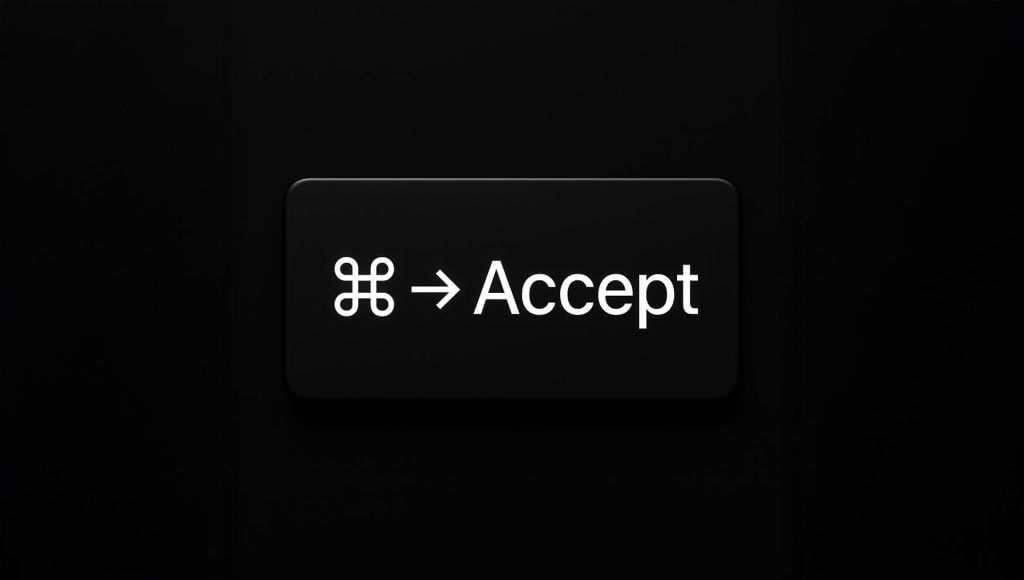Vibe coding is the process of iteratively prompting large language models (LLMs) from start to finish. This can be done manually, through agents, or in a hybrid manner. The execution happens at a higher level, significantly increasing the speed of development. By leveraging the capabilities of LLMs, developers can quickly generate code snippets, refine them, and integrate them into larger projects. This approach allows for rapid prototyping and experimentation, making it easier to explore new ideas without getting bogged down by the intricacies of traditional coding.
In vibe coding, developers often utilize AI tools to generate code with minimal hands-on programming, streamlining the development process. This relaxed approach involves inputting simple commands and receiving code in return, often troubleshooting by copy-pasting error messages, showcasing a shift from traditional programming methods to a more intuitive, conversation-based interaction with AI.
There's a new kind of coding I call "vibe coding", where you fully give in to the vibes, embrace exponentials, and forget that the code even exists. It's possible because the LLMs (e.g. Cursor Composer w Sonnet) are getting too good. Also I just talk to Composer with SuperWhisper…
— Andrej Karpathy (@karpathy) February 2, 2025
Despite its advantages, vibe coding has faced some disdain within the developer community based on its unpredictability and collaboration struggles. Critics argue that it may lead to a superficial understanding of coding principles, as the reliance on AI-generated code can bypass the need for deep programming knowledge. Additionally, there are concerns about the quality and maintainability of the generated code, which might not always meet the rigorous standards of manual coding. This skepticism highlights the importance of balancing the speed and convenience of vibe coding with a solid foundation in software development practices.
In vibe coding, the focus shifts from writing code line-by-line to guiding the AI to produce the desired output. This shift in methodology not only accelerates the development process but also opens up opportunities for non-developers to participate in coding activities. However, while vibe coding offers speed and flexibility, it also requires careful management to ensure the generated code is reliable and aligns with project standards.
As the moat of complexity in engineering code diminishes with the rise of vibe coding, companies need to turn to intellectual property (IP) protection to safeguard their proprietary processes and work products.
The Rise of AI Coding Assistant Development Tools
The introduction of AI coding assistants such as Cursor, Bolt, and Lovable Dev has significantly altered the field of software development. These tools are not limited to seasoned software engineers. They have made the task of writing code more accessible to a wider audience, including individuals without in-depth programming knowledge. AI-generated code enables developers to accelerate their projects and swiftly introduce new technologies into the market.
AI-powered tools are revolutionizing how we approach software development by lowering entry barriers. They empower those who may not be programmers traditionally to create code that might previously have seemed unattainable, thereby closing the gap between conceptualization and execution. This modern phase of agentic code development fosters an inclusive coding experience where even people with basic development skills can participate in crafting operational software—a role similar to having an experienced collaborator assist you through coding’s intricacies while you focus on inventive elements.
An integrated code editor within a cloud environment further enhances these AI-powered tools, enabling efficient coding practices and improving development skills.
Relying heavily on AI-generated content brings potential downsides. While these powerful aids can simplify the process of developing software and expedite product launches, there is a risk that understanding and maintaining generated codes could become complicated—particularly when such codes don’t conform with established standards within a project’s production environment.
In continuing this discussion later in this blog post, we will look at how these issues intersect with protecting intellectual property rights effectively amid emerging trends like ‘vibe coding’ coupled with artificial intelligence support systems—highlighting why it’s imperative your innovations remain secure amidst rapidly evolving technological landscapes involving AI-assisted enhancements in writing application programs or scripts for computers or other devices capable of processing data per prescribed algorithms (coding).
The Rise of Vibe Coding
The rise of vibe coders is a growing trend in the software development industry, driven by the increasing availability of AI-assisted coding tools. Vibe coders are individuals who use these tools to create software applications without writing code manually. The term “vibe coder” was coined to describe this innovative approach, which involves leveraging AI tools to generate code while focusing on the architecture and features of an application.
Unlike traditional software engineers, vibe coders are not necessarily experts in writing code. Instead, they have learned to work with AI coding assistants to produce code efficiently. Tools like Replit, GitHub Copilot, and ChatGPT have democratized software development, enabling non-developers to create applications without needing to write code manually. This shift allows vibe coders to concentrate on the creative aspects of software development, such as designing the user interface and user experience, while the AI coding assistant handles the actual code generation.
The rise of vibe coders is expected to continue as AI-assisted coding tools become more advanced and widely available. This trend is transforming the software development landscape, making it more inclusive and accessible to a broader audience. As AI tools evolve, vibe coders will play an increasingly significant role in shaping the future of software development.
New Feature Development in Vibe Coding
New feature development in vibe coding involves using AI-assisted coding tools to create new functionalities for software applications. Vibe coders utilize AI coding assistants to generate code for new features, which can then be seamlessly integrated into the existing codebase. This process typically begins with the vibe coder describing the desired feature in natural language. The AI coding assistant then interprets this description to generate the actual code.
Once the AI generates the code, vibe coders review and refine it to ensure it meets their requirements. This iterative process allows for rapid development and fine-tuning of new features. The efficiency of AI coding assistants means that new feature development can be faster and more accurate than traditional manual coding. The AI can generate code quickly and consistently, reducing the risk of errors and bugs.
However, effective use of AI-assisted coding tools still requires some coding experience and knowledge of software development principles. Vibe coders need to understand how to guide the AI and make necessary adjustments to the generated code. Despite this, the use of AI tools for new feature development offers significant advantages, including speed, accuracy, and the ability to focus on higher-level design and functionality.
Overall, new feature development in vibe coding is a powerful way to create new software applications and features quickly and efficiently. By leveraging AI coding assistants, vibe coders can enhance their productivity and bring innovative solutions to market faster than ever before.
As vibe coding continues to transform how software is built, it’s also changing how developers and companies need to think about protecting their creations. The accessibility and speed of AI-assisted coding raise important questions about ownership, originality, and legal safeguards. To navigate this new landscape, understanding the various types of intellectual property protection is more important than ever.
Types of Intellectual Property and Their Protection Strength
In the fast-paced world of vibe coding and AI-assisted development, understanding the different types of intellectual property (IP) and their protection strengths is crucial. Here’s a table summarizing each type of IP, their protection strength, and what they protect:
| Type of IP | Protection Strength | What They Protect |
| Utility Patents | Strongest | Unique software implementations and innovative methods; the “how” of your technology. |
| Design Patents | Strong | Visual aspects, such as user interface and unique design elements. |
| Trademarks | Moderate | Brand identity, including logos, names, and slogans. |
| Copyrights | Moderate | The actual code, or the “what,” safeguarding the written expression of ideas. |
| Trade Secrets | Variable | Proprietary algorithms or processes, maintaining exclusivity without disclosure. |
AI-powered tools can assist developers in modifying or enhancing existing code, allowing for greater control and review of the generated changes.
By strategically leveraging these types of IP, you can effectively protect your innovations and maintain a competitive edge in the realm of vibe coding and AI-assisted development.
Software Patents as Strategic Assets
Software patents are granted for inventions that demonstrate novelty, non-obviousness, and utility. To qualify for a software patent, the invention must present a unique and innovative method or process that offers a practical application. This means that the software should not only perform a task in a new way but also solve a specific problem or enhance functionality in a manner that is not obvious to someone with ordinary skill in the field.
The protection provided by software patents extends beyond the actual source and object code, safeguarding the utility and functionality of your software implementation. This includes the operational characteristics and methodologies that set the software apart from existing technologies. By focusing on the “how” rather than the “what,” software patents ensure that the inventive processes and solutions are shielded from unauthorized replication, offering a strategic advantage in competitive markets.
The Competitive Advantage of Patent Protection in the Vibe Coding Landscape
In the rapidly evolving landscape of vibe coding, acquiring patents for your essential technologies establishes a substantial defensive barrier that competitors must overcome to replicate your novel features. This strategic move ensures the exclusivity of your distinct functionalities and retains a competitive advantage in the industry. The protection afforded by these patents safeguards not only present innovations but also acts as a deterrent against potential market entrants.
As vibe coding reshapes the competitive landscape, owning a robust portfolio of patents becomes instrumental during negotiations involving partnerships or acquisitions. Entities possessing robust patent collections often appear more appealing to prospective partners and financiers due to the concrete evidence of their inventive prowess and presence in the marketplace. Employing a strategic patent portfolio with tactical acumen elevates your company’s valuation and solidifies its negotiating power within its sector.
In a world where AI-generated code and vibe coding effectively accelerate development, having a solid foundation of intellectual property protection is crucial. It not only defends your unique contributions but also positions you to thrive amidst the dynamic shifts in software development. By leveraging patents strategically, you can navigate the competitive landscape with confidence, ensuring your innovations remain secure while you explore new frontiers in vibe coding.
The Importance of Provisional Patents for Inventions in Development
Provisional patents play a crucial role for early stage inventions and inventions still under development, offering a strategic advantage in the fast-paced world of vibe coding and AI-assisted development. By securing a provisional patent, inventors can effectively “hold their place in line” within the patent system, ensuring they are recognized as the first to file. This is particularly important under the “first to file” system, where the rights to an invention are granted to the first person who files a patent application, rather than the first to invent.
The provisional patent application provides inventors with a 12-month window to further develop their invention, refine its features, and assess its commercial viability without the pressure of immediate full patent application requirements. During this period, inventors can use the term “patent pending,” which can deter potential competitors and enhance the perceived value of the invention.
Moreover, a provisional patent is a cost-effective strategy for startups and individual inventors, allowing them to secure early protection while conserving resources for further development and market testing. This approach not only safeguards the inventive concept but also provides a solid foundation for future patent filings, ultimately strengthening the inventor’s position in the competitive landscape of vibe coding and AI-generated innovations.
To convert a provisional patent into a non-provisional patent, inventors must file a non-provisional application within the 12-month period. This step is crucial as it establishes the formal patent application, which, if granted, provides up to 20 years of protection from the filing date. The non-provisional patent application requires more detailed documentation of the invention, including claims that define the scope of protection. Successfully transitioning to a non-provisional patent ensures long-term security for the invention, offering a robust shield against unauthorized use or replication in the dynamic field of vibe coding and AI-assisted development.
Beyond Patents: Complementary IP Strategies
Patents play a vital role in safeguarding intellectual property, but they represent just one approach to intellectual property protection. For parts of your technology that don’t fit the patent mold—such as the brand name or literary code, its trademark and copyrights. By protecting all aspects of your proprietary invention and branding strategies you will quickly build your intellectual property portfolio.
Trademarks and design patents are also pivotal in defending your brand’s unique identity and user interface/user experience characteristics. Trademarks help make your brand stand out from the crowd and defend against copying attempts, while design patents protect the visual uniqueness of your product offerings. Utilizing these varied strategies together boosts overall intellectual property defense by ensuring comprehensive coverage for every facet of your creative work.
Case Studies: IP Protection Success Stories
Examples from the real world underscore the significance and efficacy of strong intellectual property (IP) protection. Startups that have effectively shielded their innovations with patents illustrate that tactical IP management can pave the way for market dominance and enduring competitive edge. These triumphant accounts offer practical knowledge regarding the implementation of IP approaches.
Take, for example, firms that hold patents on their fundamental technologies frequently experience enhanced leverage in negotiations over partnerships and acquisitions. By safeguarding their inventions, these organizations are able to preserve their position as market leaders and continue pioneering without constantly facing potential infringement risks.
These illustrative examples emphasize how essential it is to engage in proactive intellectual property protection if one aims to secure sustained success over time.
The Cost-Benefit Analysis of Patent Protection
Securing patent protection requires a considerable financial commitment, underscoring the need for a detailed cost-benefit assessment. To evaluate whether seeking patent rights is prudent or unnecessary, it’s important to estimate the potential return on investment (ROI) of patents. This estimation should take into account variables like anticipated market influence, how novel the innovation is, and existing competitive dynamics.
For some innovations—particularly those that are smaller in scope or not as revolutionary—the expenses involved with obtaining and upholding patents might surpass any advantages gained from them. Conversely, inventions that represent significant advancements and have substantial commercial promise may reap considerable benefits from being patented.
By meticulously weighing costs against benefits, you can make educated choices regarding your intellectual property (IP) strategy and guarantee that your investments lead to favorable results.
Speed vs. Understanding: A Double-Edged Sword
The emergence of AI tools designed for coding enables developers to swiftly progress in their projects, although this convenience may come at the cost of a deep comprehension of the code being produced. Although AI generated code can expedite the development workflow considerably, it tends not to be as clear or conformant with established coding norms compared to code that is crafted by hand. Such discrepancies could lead to an accumulation of technical debt and a subsequent augmentation in complexity within the production codebase.
The shift towards vibe coding, where users prompt AI to generate code instead of writing code directly, is revolutionizing the programming landscape. This approach removes the need to write every line manually, making software development accessible to those lacking traditional coding skills.
Relying on AI-generated solutions for generating code brings certain risks, especially when deployed within live production settings. Programmers might find themselves challenged by understanding or troubleshooting ai generated codes due to potential deficits in maintainability and robustness. Employing vibe coded strategies during production stages carries its own set of hazards since such generate codes are less likely ruggedly built or thoroughly documented like conventional manually-coded alternatives. Hence, ensuring reliability and ease-of-maintenance in generate codes remains paramount.
Striking a balance between leveraging the swift capabilities offered by AI-generated codings against fully grasping their underlying tenets is key. To reduce some inherent perils linked with rapid development pace provided by these powerful aids, integrating context-providing measures alongside employing performance assessment instruments prove beneficial. By embracing industry best practices diligently focused on excellence, developers can capitalize on what AI tools have got up their sleeves while averting possible adverse effects effectively.
Future Trends in Software Development
In the future, AI coding assistants are anticipated to exhibit enhanced contextual understanding, leading to better and more precise recommendations for coding. This advancement will improve developers’ ability to efficiently craft high-quality code by streamlining their programming endeavors. As organizations prioritize productivity outcomes, the impact of these AI tools on efficiency will become increasingly evident, spurring greater uptake.
Simultaneously, the legal framework pertaining to content created by AI is undergoing changes. The debate around copyright ownership and acknowledging artificial intelligence as creators has intensified. South Africa stands out for its recognition of inventions produced by AI systems. Escalating regulatory attention underscores a growing need for definitive regulations concerning copyrighted material utilized in training AIs and safeguarding intellectual property generated by them.
Given these developments, it is clear that artificial intelligence tools are set to take on an expanded role within the realm of software development moving forward. Developers who keep abreast of legislative shifts and incorporate best practices in integrating such tools into their workflows will be well-prepared for success amidst this swiftly evolving technological environment.
Best Practices for Integrating AI Tools for Software Engineers
Incorporating AI coding tools into DevOps workflows has the potential to significantly improve the efficiency of code review, testing, and deployment processes. It is imperative to meticulously record both the origin and subsequent alterations made to ai-generated code for clarity and ease in future upkeep, thereby keeping it comprehensible and manageable. Crafting precise prompts can considerably enhance the caliber of AI-generated outcomes, resulting in more reliable and uniform code.
To ensure that generated code meets project benchmarks and requirements, an iterative development methodology should be employed which emphasizes constant feedback loops as well as rigorous testing. This helps sharpen the quality of AI coding outputs. Diversifying one’s use of APIs by adopting a strategy that employs multiple providers mitigates risks linked with dependency on a single source for ai services. This promotes robustness within your development operations.
It is essential for aligning these advanced AI tools with pre-existing standards in coding practices so as to reduce any discrepancies while safeguarding overall integrity within our repositories. By adhering rigorously to best practices such as these guidelines, developers may fully harness their strengths: integrating state-of-the-art capabilities from AI instruments responsibly woven into their existing work patterns—thereby reaping enhanced productivity without sacrificing software dependability or excellence.
Summary
In this era where AI-assisted development and vibe coding are prevalent, the importance of securing your intellectual property cannot be overstated. Grasping the critical role that patents play and implementing additional IP strategies is essential to shield your innovations and preserve your competitive advantage in the marketplace. Although vibe coding presents enticing opportunities for swift development and inventive exploration, it also brings about challenges demanding vigilant management along with firm IP safeguards.
Looking ahead, being well-informed about shifts in legal frameworks and regulatory landscapes, as well as applying best practices concerning AI tools, will prove indispensable for triumph. While you leverage the potential offered by vibe coding and artificial intelligence, ensure you have a definitive plan for protecting your intellectual assets. Taking deliberate measures can help guarantee that your innovative activities remain protected, allowing you to continually forge new paths within this vibrant field’s constant evolution.
Frequently Asked Questions
What is vibe coding and how does it differ from traditional coding? Tips for vibe coding effectively.
Vibe coding prioritizes speed and creativity, allowing developers to create working code quickly while focusing less on precision and detailed understanding. In contrast, traditional coding emphasizes a meticulous approach, making vibe coding a refreshing and innovative way to engage with programming.
How do AI-assisted development tools impact the coding process?
Development tools enhanced by AI accelerate the process of coding and lower the barrier to entry, enabling individuals with limited programming backgrounds to craft inventive solutions.
Adopting such instruments can result in a swifter development cycle and open doors to thrilling advancements in the tech sphere!
Why is IP protection important in the age of vibe coding?
IP protection is crucial in the age of vibe coding as it acts as a safeguard for your innovations, ensuring they remain exclusive and giving you a competitive advantage. With the rapid development facilitated by AI tools, protecting your intellectual property prevents unauthorized use and replication of your unique ideas and functionalities. This protection not only secures your current innovations but also allows you to confidently explore new
What are the strategic benefits of obtaining software patents?
Securing patents for your software fortifies the defense of your novel functionalities, constructing obstacles that hinder competition and bolstering leverage during negotiations for collaborations or buyouts.
Such a tactical benefit can fuel expansion and solidify your foothold in the marketplace!
What are some best practices for integrating AI tools into development workflows?
To effectively integrate AI tools into development workflows, document AI-generated code changes and provide clear prompts for better results.
Adopting an iterative approach while aligning with coding standards will boost your productivity and maintain code quality!



